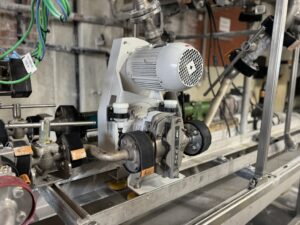Keeping wastewater arteries clear

Throughlet size diameters ensure optimum performance. (Image source: Sulzer Ltd.)
Pump blockage is a growing and costly issue for wastewater companies. Choosing a pump designed specifically to meet the challenges of frontline operation in sewage networks can dramatically cut downtime and minimize asset lifetime costs.
Water rates affect everyone and they are largely dictated by the costs of extracting, treating and cleaning water as it travels through the water cycle. Therefore, any savings that can be made in efficiency and operating costs can have a beneficial effect on the bottom line for utilities, which should be reflected in customers’ bills.
Solids removal is the first process at any municipal wastewater treatment facility. The screens installed at the inlet of the treatment works capture large quantities of material, mainly composed of wipes, sanitary items and – in combined sewage and stormwater management systems – litter from the streets. One terminal pumping station in Spain, for example, collects around 1.6 m3 of fibrous materials, equivalent to approximately 200’000 wet wipes, from the 28’000 m3 of wastewater it pumps every week.
Meeting the challenge for pumping stations
The need to process high volumes of solid material is not only a costly inconvenience for wastewater companies, but also presents a significant operational challenge. Network pumping stations, which deliver raw wastewater to the terminal pumping station, and from there to treatment facilities, don’t benefit from protective screens and must be able to handle the solid content within.
If a pump becomes blocked, the first indication operators receive is usually an alert via their telemetry system indicating a tripped motor protection switch. Most stations are equipped with two or three pumps, allowing them to keep operating with one unit off-line. However, a failure still requires the urgent dispatch of a maintenance team to lift the affected pump and clear the blockage before reinstalling and testing the pump. This would require two technicians travelling to the site and working for approximately two hours. Repeated occurrences across the network can significantly increase maintenance costs for the utility company.
To address the problem of blockages in network and terminal pumping stations, leading original equipment manufacturers (OEMs) have optimized the design of the impellers. In Sulzer’s case, the introduction of the ContraBlock (CB) Plus impeller has delivered a considerable improvement in performance. This design can dramatically improve both the blockage resistance and the ability to maintain efficiency throughout the lifetime of the pump. The design has proven to handle sewage containing wipes, solids and fibrous material, with throughlet size diameter of 75 mm for smaller pumps or 100 mm for larger units of DN100 and above, according to various standards associated with wastewater management.
Optimized impeller design
In 2009, Sulzer started introducing the first one-channel Contrablock Plus (CB Plus) impeller and in 2013 the first two-channel CB Plus impeller. Since then, the range keeps expanding.
The design uses a large radius and backswept leading edge vane with a tapered profile that encourages material not to become ‘hung up’ on the vanes, instead directing it to slide off into the downstream flow. Any remaining fibrous material that does catch on the impeller vanes will slide down the inclined leading edge profile and be sliced clear when it comes into contact with the plate below the impeller.
At the same time, a conical upper disk moves solid material outwards as the impeller spins. A conical hub cover with a matching profile prevents material from becoming trapped at the impeller-shaft interface. The geometry of the impeller ensures that the overwhelming majority of solids will pass straight through the pump. Special interrupted slots in the bottom plate maximize the disintegration of material without compromising hydraulic efficiency.
Any impeller operating in demanding wastewater conditions will eventually be subject to wear, leading to an efficiency reduction of approximately 2% after 2’000 hours of operation (one to two years of use in most pumping stations). Ideally, wastewater pumps should incorporate wear compensation features, such as wear rings, into their design that allow adjustment back to optimum efficiency.
In the case of the CB Plus, the bottom plate uses a precisely machined conical design that allows the gap between the plate and the impeller to be set at the optimal spacing for overall pump performance. Routine on-site maintenance can include a simple manual adjustment that allows the optimum gap to be re-established, bringing pump efficiency back to the as-new condition. In contrast, the replacement of a wear ring cannot be achieved on site and will require the pump to be repaired in a local workshop.
Network and terminal pumping stations are the front line of every large-scale wastewater treatment system. Operators need to ensure that their systems can provide continual availability and high levels of reliability without excessive energy consumption and in turn minimize increases in rates for customers. Working with an experienced OEM to select the right pump design for each part of the network can make a significant difference to all those parameters, leading to big savings over the lifetime of the assets.
Source: Sulzer Ltd.





